Camphor Benefits, Dose, Research, Side Effects
Camphor is a rare herb which, being coolant, balances Kapha Dosha and reduces fat and cholesterol levels. Camphor used for medicinal use is slightly different than the camphor used in Pooja / Spiritual practices. In the market, you get the edible camphor usually in powder form. Though modern science categorizes it as unsafe for oral consumption, in a very low specified dose, it is useful in certain diseases.
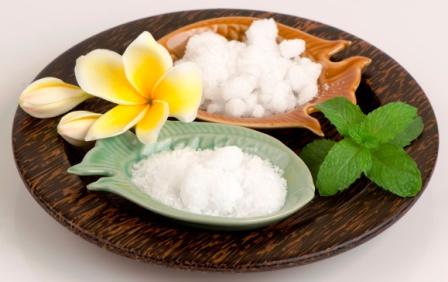
Botanical Name- Cinnamomum Camphora Nees & Eberm
Family- LAURACEAE (Karpura kula)
Natural camphor is obtained by distilling the bark and wood of the camphor tree Cinnamonum camphora. Synthetic camphor is manufactured from turpentine oil.
Table of Contents
Medicinal Properties
Rasa (taste) – Tikta (bitter), Katu (pungent), Madhura (sweet)
Guna (qualities) – Laghu (light to digest), Rooksha (Dryness)
Vipaka-Katu – undergoes pungent taste conversion after digestion.
Veerya – Sheeta – coolant in nature.
Effect on Tridosha – Balances Kapha and Pitta Dosha.
Part used, dosage
Part Used- Niryasa (extract)
Dosage – 125-375 mg, in divided dose per day.
Morphology
Tree, glabrous in nature
Leaves – Alternate, coriaceous, long petiolate, ovate, 3 nerved, uniformly coloured on both sides or pale below
Inflorescence – Panicle
Flower – Calyx is yellow, slightly longer than the pedicel
Fruit – Round, fleshy, 3 – 5 cm long and black in colour
Useful part – Camphor – Resinous exudate – Colourless, crystalline, solid granular mass known as flower of camphor. It has characteristic odour and aromatic pungent taste followed by a sensation of cold.
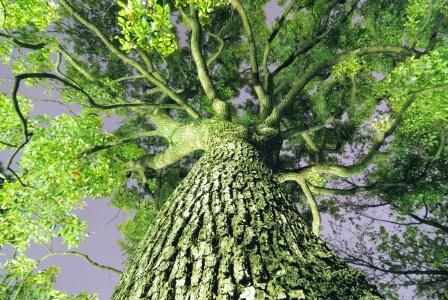
Camphor uses
Camphor is one of the rare herbs which, being coolant, is useful to balance Kapha Dosha.
Camphor for heart, fat and cholesterol –
Chedana, Lekhana – has scraping property, useful in balancing Kapha, in respiratory disorders and in cholesterol / clot deposition in blood vessels
Medohara – reduces fat and cholesterol levels
Camphor acts as a blood thinning agent. It is also used in low blood pressure.
Camphor with mustard oil:
Camphor 10-20 grams is dissolved in 100-150 ml of mustard oil. This oil is rubbed over the fat deposited areas like chest and abdomen for 15-30 minutes. This helps to reduce obesity.
Camphor for oral disorders:
Mukhashoshahara – Relieves mouth dryness
Mukha vairasyahara – Relieves bad breath problems. This is why camphor has been used as an ingredient in betel leaf combination – Pan – Tambul
Kanta Doshahara – clears throat.
It relieves toothache.
Vishahara, Vishapaha – Anti toxic
Chakshushya – improves vision, good for eyes, useful in eye disorders
Madakaraka – overdose may cause intoxication.
Yogavahi – acts as a catalyst
Dahahara – being a coolant, it relieves burning sensation
Vrushya – acts as aphrodisiac in lower doses. However, higher doses decrease sexual performance.
Medhya – improves intelligence
Kruminashana – relieves intestinal worm infestation
The Cheenaka variety of Karpoora is Ati Pittala – increased Pitta Dosha.
Inhalation of its vapors helps in relieving chest congestion due to excessive sputum. It is also used in the treatment of coughs.
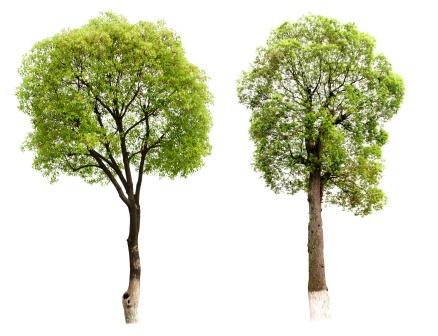
The karpoora is basically hot in initial effect and penetrating in nature, but in due course when consumed it transforms to provide coolant effect.
It alleviates pruritus, prameha, nasal discharge, worms, thirst, dyspnoea, cough etc.,
Being kaphaghna in nature it provides relief from throat irritation and pain.
When consumed the karpoora causes a numb feeling in the tip of the tongue [su supta jihvA agrajit].
The karpoora acts as digestive and reduces the pitta dosha.
It is occasionally referred to with an alternative term, the sphatika, since it resembles the whitish colour of the Alum.
The karpoora is also beneficial in eye diseases; it alleviates the thirst and burning sensation.
It improves blood circulation and thereby addresses the penile erection.
External application:
Camphor oil is used externally to treat arthritis pain and rheumatism.
A teaspoon of Camphor oil is mixed along with 100 ml of olive oil / sesame oil. This is applied externally to improve blood circulation.
Camphor is FDA approved for external application in a concentration of 3 – 11 %
In preparing liniments:
Herbal oils are mixed with camphor, menthol, thymol, Eucalyptus oil etc, to prepare pain relieving liniment. This liniment gives a coolant / counter-irritant effect to the liniment. It also makes the liniment to evaporate from the applied body part.
Qualities as per Bhojana kutuhalam
Properties of camphor:
Rasa – Tiktha (Bitter), Katu (Pungent)
Veerya – Cold in potency
Balances kapha dosha, helps in treating bleeding disorders, thirst, burning sensation, disorders of throat and pain in the eyes.
Camphor which is obtained from within the stem is considered to be superior and the rest are of intermediate attributes. The superior variety is slightly yellowish in color while the other one is fully white. Camphor which is white in color, rough in touch, firm and expanded should be understood as having been formed externally.
Home remedies
By Dr MS Krishnamurthy MD(Ayu), PhD
Chest congestion
1. Camphor dissolved in oil in chest congestion:
5 grams of camphor is taken and added to 100 ml of warm sesame oil and dissolved. This is used to apply over the chest. Simultaneously this can be used for inhalation also. This relieves cough, breathlessness, nasal blockage and chest congestion caused due to asthma.
Cough
2. Camphor mixed with honey in cough and throat irritation:
500 mg -1 gram of camphor is powdered well and mixed with half spoon of honey. This is consumed by licking. This pacifies cough, cold, throat pain and irritation of the throat.
Flatulence
3. Camphor pill in flatulence (gas), indigestion, headache and anorexia:
Camphor, rock salt, cumin seeds and cardamom or clove are taken in equal quantities and fine paste is made. This is mixed well and rolled into the pills of 125-250 mg size. This is dried under shade and collected and stored. This is taken along with warm water or cumin herbal tea.
Joint pain
4. Oil of camphor-thymol and sunflower oil:
10 gram camphor, 5 gram thymol and 200 ml of sunflower oil are taken together and slightly warmed (do not heat more as the camphor and thymol may be lost due to heat).
This is taken out of the fire and allowed for cooling. Meanwhile this is constantly stirred to avoid precipitation.
This oil is applied over the painful joints and muscular regions. In calcaneal spur, back ache, neuralgia etc also this can be used.
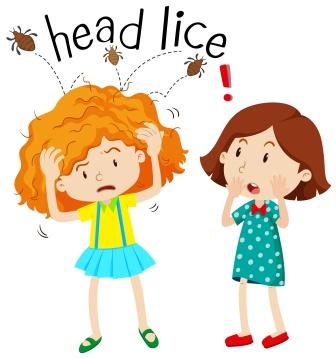
Head lice
5. Camphor home remedy for head lice and burning sensation:
10 grams of camphor is dissolved in 100 ml of warm coconut oil. Allowed to cool down. This is applied on the scalp in case of burning/ headache.
In case of head lice, this is applied to the whole scalp at night. Next day morning, hair is washed.
Wounds
6. Camphor powder dusting:
Camphor is a very good cleanser. Dusting of the fine powder of camphor over the wounds and cracks helps to heal the wound faster.
Click to consult Dr MS Krishnamurthy MD(Ayu), PhD
Varieties
Different Varieties of camphor:
Dhanvantari Nighantu Sodhala mentioned Pakva (artificial), Chinaka and Apakva (natural) varieties of Kurpura.
Bhava Prakasha and Raja Nighantu also mentioned similar varieties.
According to Kaiyadeva, there are three varieties – Ishavasa, Hima sanjnaka & Potashraya.
Later, he quoted that Karpura is two types based on the processing i.e Pakva (prepared) and Apakva (natural).
He further explained that the Chinaka variety is artificial camphor.
In Raja Nighantu about 14 types of Karpura on the basis of Rasa, Guna and Veerya
Usually, the camphor found on the tree pits and branches is called Apakva (natural) Karpura. The camphor prepared by using distillation procedure is the Pakva(artificial) variety of Karpura. The former variety will be heavier than the later and sinks in the water.
There is a variety called Bhimseni Karpoora – which is correlated to Dryobalanops camphora Colebr (DIPTEROCARPACEAE)
Chunekarji explained four varieties of camphor viz.
(i) Bhimseni or Baras Karpura (D. Camphora)
(ii) Cini or Japani Karpura (D. camphora)
(iii) Patri or Nagi Karpura- Blumea balsamifera; B.Lacera B. desiflora etc.
(iv) Krutima Karpura- Synthetic variety camphor.
(v) Nowadays camphor is being synthetically prepared by using turpentine. This is however used for offerings to god. It is not meant for medicinal use.
Distribution
Native of China, Japan and Taiwan.
Chemical composition
Cinnamomum camphora – chemical composition:
Campher, Campherol, Cineol, Camphene, dipentene, terpineol, candinene, safrole, camphorace, laurolitsine, reticuline etc.
(Reference: Illustrated Dravyaguna Vijnana, Vol. II, by Dr JLN Shastry)
Modern science has accepted its potent effect with respect to its Stimulant and diaphoretic effect, antiseptic action, disinfectant- insecticide-and germicide properties, carminative ability, antispasmodic, aphrodisiac and anti inflammatory action, sedative and decongestant properties with respect to human body.
Method of Preparation
The wood is reduced into small pieces of chips and subjected to steam distillation. Distillation is performed at 80 to 100 pounds psi pressure. Crude natural camphor oil, thus obtained contains a variable quantity of camphor which is then purified by sublimation. About 1 kg of crude camphor is obtained from 40 to 50 kg chips of the crude Drug.
Chemical test
A drop of solution of Vanillin (1:100) and Sulphuric acid when added to powdered natural camphor, produces immediately a yellow colour, changing to red, violet and finally blue. Synthetic camphor does not respond to this chemical test.
Research
Sanskrit verse
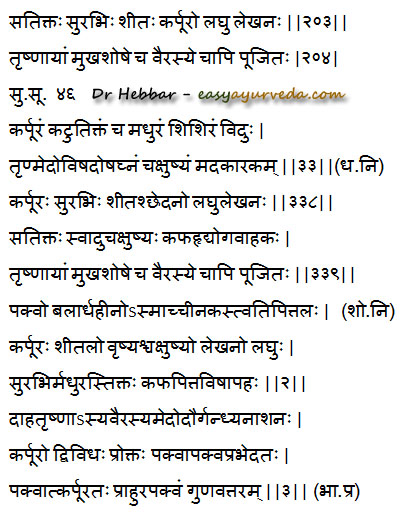
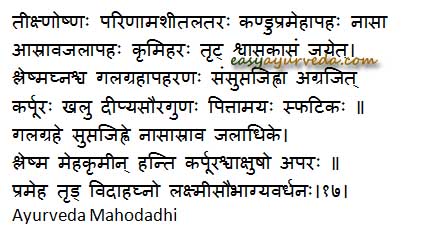
Side effects
For external application, in any product, the camphor concentration should not be more than 11 %
Artificially prepared camphor made from turpentine is not suitable for oral consumption. Do not confuse it with the edible camphor.
Camphor is used in treating low blood pressure. Hence, it is not suitable for people with high blood pressure.
It is best to avoid its usage in epilepsy and Parkinson’s disease patients.
Its oral usage should only be done under strict medical supervision.
It is not meant to be consumed by children, pregnant and lactating mothers. However, it can be safely used by external application methods.
Camphor oil should not be directly given for asthmatic patients to inhale. It may trigger spasms.
Camphor poisoning – overdosage may lead to seizures, confusion, restlessness, nausea, vomiting etc.
Interaction with medicines, supplements
Can this be used while taking Homeopathic medicine?
Yes. This product does not react with homeopathic medicine.
Can this medicine be continued while taking supplements like multivitamin tablets, Omega 3 fatty acids etc?
Yes. Generally, this product goes well with most dietary supplements. However, if you are taking more than one product per day, please consult your doctor for an opinion.
With western
medicines
Seek your
doctor’s advice if you are taking this product along with other western
(allopathic / modern) medicines. Some Ayurvedic herbs can interact with modern
medicine.
If both Ayurvedic and allopathic medicines are advised together, then it is
best to take Allopathic medicine first, wait for 30 minutes and then take the
Ayurvedic medicine.
Ayurveda medicines
Ayurveda medicines with camphor as ingredient:
Vayu Gulika – used in treating cough, cold, fever etc. It is used mainly in respiratory and gastric conditions.
Kombanchadi Gulika – used in treatment of fever, cough and cold
Gandhaka Malahara – An ointment used in eczema and itching skin disorders
Karpoorasava – used in the treatment of vomiting and diarrhea.
Manasamitra Vatakam – used in Ayurveda treatment of psychiatric conditions, to improve intelligence, speech problems, etc.
Vernacular names
Names in different languages:
Hindi & Bengali Name-Karpur
English Name- Camphor tree, Camphor laurel
Kannada Name – Pache karpoora
Telugu Name- Karpooram Chettu
Tamil Name- Karpooram, Pachai Karpooram
Marathi & Gujarati Name- Karpur
Sanskrit synonyms
Ghanasara – Exudates resemble white cloud
Chandrapradha – the shining resembles to that of moonlight
Sheetabhra, Sheetala Raja – coolant to touch
Hima, Himavaluka – appears similar to ice particles
Surabhi – emits fragrance
Sphatika – as white as alum
Himavaluka – Exudate resembling sand particles, will have sita virya
Chandrasamja – Karpoora having cooling effect that of moon, also bright and pleasant
Systemic Action (Sthanika Karma)
External –External application helps to reduce pain, inflammation, good for the eye. First it stimulate nervous. Indicated in Akshepa vata roga (Convulsions / spasm). Cause stimulation of higher centers of breathing and circulation. In liniment form it can be applied to wounds. Oil is indicated in joint pain, cough, pain in flanks etc. Powder can be sprinkled on wounds along with other herbs. Along with peppermint it can be applied to reduce pain. Used for brushing teeth in case of tooth ache. In Rhinitis it can be given as Nasya.
Digestive System – Cleanses oral cavity, prevents bad odour. promote circulation of the oral cavity, stimulate salivary glands, and eliminate excess kapha. Increase taste sensation, reduce excessive thirst. Stimulate the production of stomac acids. Carminative and digestive, helps for the movement of doshas in the proper direction. Over dosage can leads to loss of taste, vomiting and nausea.
Circulatory System – Stimulate and protect heart, . elevate blood pressure and constrict blood vessels. Strengthen Cardiac muscle.
Respiratory System – Indicated in cough, breathing difficulty and in diseases related to throat. Helps to eliminate kapha dosha.
Excretory System – Increases urine production indicated in dysuria and pus in urine.
Reproductive System – In lower dose act as Aphrodisiac but in higher dose it reduces sexual urges. Indicated in Impotency. Reduces milk production in lactating mother
Skin –Indicated in burning sensation and stimulates sweat glands.
Satmikarana – It has Scraping action and is anti poisonous.
Tapakrama – Indicated in burning sensation









51 comments
Maah
Such an interesting compound. Smells so purifying. We used to make a thinnish sweet rice with milk, basmati rice, few bay leaves, bit of black pepper and pinch of camphor. Camphor should not really be tasted, just hinted at. And sugar, of course.. and offered to Lord Jagannath. A small piece of camphor is very helpful in starting fires for the homa; Is often used alone and lit on fire on a brass plate with flowers and a bit of water to offer before the Sri Murthis in arati. Thank you.
Dr J V Hebbar MD(Ayu)Author
Very serene and pleasing to read these inputs 🙂
RV
What is the difference between camphor and brass kapur?
Dr J V Hebbar MD(Ayu)Author
As per my knowledge, Brass Kapur refers to Camphor used in Pooja (Hindu religious practices). It contains camphor plant product along with certain chemicals to help it burn better. That is not edible.
camphor is directly from plant, without any additives, and is edible.
Mohit
Sir, Where we can buy a Camphor without Wax ? Is that natural kapoor or Bhimseni kapoor ?
murthy
Well written. I am now clear with harathy karpur and edible/Pacha karpur. The former is mostly synthetic derived from turpentine & the later a plant product obtained be suitable distillation. Thank you for giving such a nice article my friend.
Dr J V Hebbar MD(Ayu)Author
Thank you.
Dr Malini Bhat
Dear sir, Edible Camphor should not be confused with normal camphor which we use for performing pooja and eliminating kan drishti. Normal camphors are made artificially from chemicals, mainly from turpentine. Edible camphor should not be consumed in large quantities but a pinch of it can be consumed. It is better to avoid giving it to children, pregnant and lactating women.
Following are some of the serious Camphor side effects which can remind you that camphor should only be used in moderate quantities:
• Camphor may cause the lips to over dry.
• Camphor leads to skin redness and rashes when over-used.
• Camphor is highly toxic for humans. Its small amounts too can lead to death in children and toxicity in adults. Camphor hepatotoxicity is a serious side-effect of camphor ingestion.
• Camphor can cause acute chemical imbalance in the brain. This leads to seizures. This is a very serious side effect of camphor ingestion.
Dr Malini Bhat
Madam, As it is for a kid a expert supervision is highly recommended. Camphor oil can cause burning so I would not advise you to apply that.
sunil
Sirji now days we are getting camphor tablets with mixing of hexamine powder how much dangerous its for us while we are using in temples homes
Dr Malini Bhat
Hello Sir, Bhimseni Karpoor is the camphor we use it in Puja. The one used is fistula is Cinnamonum Camphora which is different from the Bhimseni camphor.
Do consult a Ayurvedic physician for the same.
Alka
My grandmother used Kapoor as one of the ingredients to making Kaajal. Wondering if Pache karpooram can be used in Kaajal? Where can we buy Pache karpooram from?
Suresh Kumar
Is Eladi Oil will be available in Delhi Region.
Veer Kashyap
How can edible camphor help in treating external piles?
Please suggest
Dr J V Hebbar MD(Ayu)Author
Not much useful.
Tanmay
I had came across a kapur that has yellow orange color sand like granules with white granules also. The man told me it’s bhimseni kapur.Please tell me if it’s right .
Dr J V Hebbar MD(Ayu)Author
Bhimseni karpoor is yellow + white in colour.
mohinder
What is the use of Bhimseni Kapoor in Piles?
Dr J V Hebbar MD(Ayu)Author
Reduces pain and itching.
N parvez
Sir please suggest whether bhimaseni kapur is use full in treatment of fistula. Iam taking this kapur with banana is it use full for fistula Or plz suggest any other medicine or herbes for treatment of fistula
Dr J V Hebbar MD(Ayu)Author
It is useful to some extent.
Dr J V Hebbar MD(Ayu)Author
Will write about it.
G VIJAYALAKSHMI GOVINDARAJAN
Can we use pacchai karpooram along with chukku malli kashaayam to drink
Dr J V Hebbar MD(Ayu)Author
Hi, just keep 1 gram of Bhimseni kapur in a bowl in some corner of the room. This should be sufficient for a day.
Varsha
Hallo Dr.
Kya mai Bhimseni Kapoor raat me Pani me dal ke dusre dinbhar Pani pi Sakti hu kya. I m 50 yrs old.
Varsha
Thanks.Dr
Ravi Yadav
Hello Dr,
I am not able to comment, so replying here.
Please guide me with name of any company which makes pure camphor, I want to use it on my face to remove acne marks so please suggest me which is good for my need.
Thanks
Dr J V Hebbar MD(Ayu)Author
It can be continued for 20 more days.
Shiri
Hi Dr,
I want to prepare kajal with bheemaseni camphor and some other ingredients, Is there any effect with camphor. Please suggest me.
If it is good to use which product is helpful,
Thanks in advance
Dr J V Hebbar MD(Ayu)Author
It is good to use bheemseni camphor for kajal preparation.
Nadkarni
Sir There is so much price variation in the market, is there any way to check if Bhimseni Kapur is natural or not ?
Dr J V Hebbar MD(Ayu)Author
Hi, I do not know of any.
Deepti Ahuja
Hello Sir,
I have anal fissures. My doctor has already given me some medicines. Someone advised me to take Camphor with banana for a week. Is it advisable to take camphor alongwith the medicines prescribed by the doc ??Also which camphor is advisable to be taken? Please let me know at the earliest.
Thanks
Namrata
Hello Sir,
Can you please guide me if i can use camphor in hair oil? which karpur can be used? and is it beneficial and in what quantity?
Dr J V Hebbar MD(Ayu)Author
Camphor is not much used in hair oils. But if you want, you can add Bhimseni camphor – 3 grams per 100 ml of oil.
Ashok
Hello Doctor,
Home made cold rub from pucha karpuram preparation at home,please explain about ingredients and quantity
Regards
Ashok
Dr J V Hebbar MD(Ayu)Author
Please read other ingredients here – https://www.easyayurveda.com/2012/05/27/how-to-make-ayurvedic-herbal-bath-powder-at-home/
You can use the fine powder of those ingredients + add 5 % of karpuram and use it as cold rub.
S M Nadkarni
Hello Sir,
I have heard that Bhimseni Kapoor is good for curing fungal infection in nails of our feet. Is it true? How to use it ? Look forwards to your valuable advise.
Maan Singh
Dear Doctor sahab, pl intimate if camphor is treatment for piles, if so qty and methodology may kindly be given.
Regards- Man Singh
Ankita
Hello doc I am 23 weeks pregnant and had boondi Ladoo which has edible camphor in it.. is it something very dangerous? I read camphor should not be eaten while pregnant? Please let me know
Dr J V Hebbar MD(Ayu)Author
It is not very dangerous. Nothing to worry. Avoid it in future.
Sonia
Hello sir
I have heard that Bhimseni Kapoor is good for curing bronchitis is it true ? How to use it ? Please let me know
Thanku !
Dr J V Hebbar MD(Ayu)Author
I would not recommend it as a single medicine for bronchitis.
Sumeet Barnwal
Hello sir..
I used camphor in paan masala 5 to 6 times daily. And which camphor does paan Wala guy uses don’t know about that, so is there any side effects to consume. Sir pls let me know.
Dr J V Hebbar MD(Ayu)Author
Edible one is called Bhimseni kapoor. Do not use the regular one for eating.
HarishR
Sir, Kottakals karooparadhi tailum has 2.5 gms for 10 ml , we are using it daily for external application. Is it any harm. Plz clarify if you see this comment.
Dr J V Hebbar MD(Ayu)Author
Hi, because camphor is a nerve and skin stimulant, I do not recommend using it on a daily basis for more than 2 months.
Anuja Varma
Apart from the above benefits Camphor has a lot of other benefits. Scientifically known as Cinnamomum Camphora, Camphor is harvested from camphor trees and later processed through steam distillation. Camphor belongs to the Laurel family, which is scientifically known as Ocotea Usambarensis. The chemical formula of this naturally occurring organic substance is C₁₀H₁₆O. It is used as an effective remedy for joint pain as it stimulates the circulatory system. This helps tackle rheumatic diseases, gout, and osteoarthritis. Muscle stiffness, cramps, spasms, and joint and shoulder pain can also relieve in less than 2 weeks with the use of camphor. This antispasmodic can also help promote a sense of calm during pregnancies. Moreover, ingesting camphor in limited and moderated quantities can help reduce the formation of gas as it improves digestion and helps increase metabolism.
Camphor can also act as a remedy for those with stubborn nail fungus that has a tendency to recur. Regular use of this antifungal ingredient can help treat similar infections in a period of 3 weeks.
v
Sir..
I saw a remedy on a tv show to reduce fat with camphor.The recipe calls for mixing 100 ml of warmed mustard oil with 20 grams camphor and kept aside with the lid covered till the camphor dissolves.This oil when massaged regularly 30 mins before bath to the body except head is believed to be good in reducing body fat.However,the ayurvedic doctor did not mention the type of camphor that must be used for this purpose.I heard different names for camphor in telugu, such as muddha karpooram, harathi (pooja)karpooram,pacha karpooram.Kindly throw some light on this and mention what type of camphor should be used in the above remedy.What is edible camphor in telugu?
Dr J V Hebbar MD(Ayu)Author
For external application, any type of camphor can be used.
Pratap Kulkarni
When I had enteric fever Typhoid, I was given medicine based in Camphor
It cured me in week